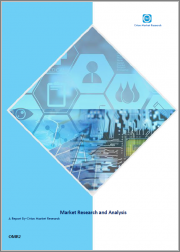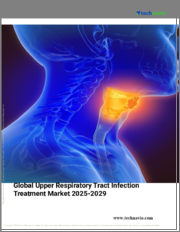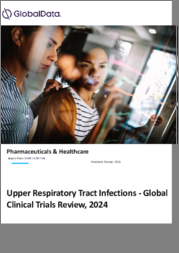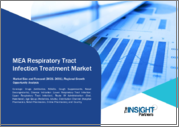
|
시장보고서
상품코드
1351035
세계의 상기도 질환 치료 시장(2023-2030년)Global Upper Respiratory Tract Disease Treatment Market 2023-2030 |
||||||
세계의 상기도 질환 치료제 시장은 예측 기간(2023-2030년) 중 3.6%의 CAGR을 나타낼 것으로 예상됩니다. 상기도 감염(UTI)은 코, 부비동, 인두, 후두 등 상기도에 발생하는 급성 감염으로 인해 발생하는 질환입니다. 일반적으로 코막힘, 인후통, 편도선염, 인두염, 후두염, 중이염, 감기 등이 이에 해당합니다. 이 감염은 박테리아나 바이러스와 같은 질병을 유발하는 병원균을 표적으로 삼아 다양한 약물을 사용하여 치료할 수 있습니다. 천식, 울혈성 심부전, 만성폐쇄성폐질환(COPD)을 앓고 있는 성인 증가는 호흡기세포융합바이러스 감염에 걸릴 위험이 높아 시장 성장에 영향을 미칠 것으로 보입니다. 미국 plos computing biology의 연구에 따르면 호흡기 증후군은 다양한 박테리아와 바이러스에 의해 발생하며, 감염은 가벼운 감기부터 생명을 위협하는 폐렴까지 다양합니다. 가장 흔한 질병 중 하나인 UTI의 2019년 세계 부담은 172억 달러로 추정되며, UTI에 걸린 대부분의 개인은 경미한 증상을 보이지만, 미국에서만 독감과 관련이 없는 바이러스성 UTI의 경제적 부담은 225억 달러로 추정됩니다. 20억 달러가 지출되고 있는 것으로 추정됩니다.
부문별 전망
감염성 또는 세균성 질환. 또한 상기도 감염으로 인한 의사 방문이 증가하고 있으며, 이러한 감염을 치료하기 위해 일반 의약품에 대한 수요가 증가하고 있습니다.
상기도 감염 치료제 세계 시장에서 항생제 하위 부문이 큰 비중을 차지할 것으로 예상
약물 유형별로는 항생제 하위 부문이 세계 상기도 질환 시장에서 상당한 점유율을 차지할 것으로 예상됩니다. 이 부문의 성장은 아프리카, 스리랑카, 파키스탄과 같은 많은 국가에서 상기도 질환 증가와 의사 및 적절한 의료 처방의 가용성 및 저렴한 비용으로 인한 것입니다. 상기도 감염과 그 증상을 치료하기 위한 항생제를 쉽게 구할 수 있으므로 항생제에 대한 수요가 증가하여 상기도 감염 치료 시장을 촉진할 것입니다.
지역 전망
세계 상기도 감염 치료제 시장은 북미(미국, 캐나다), 유럽(영국, 이탈리아, 스페인, 독일, 프랑스, 기타 유럽), 아시아태평양(인도, 중국, 일본, 한국, 기타 아시아 지역), 기타 세계 지역(중동 및 아프리카, 라틴아메리카) 등 지역별로 세분화됩니다. 세분화되어 있습니다. 이 중 아시아태평양은 중국, 인도, 인도네시아 등의 국가에서 세균성 및 바이러스성 질환 증가로 인한 수요 증가로 인해 세계 시장에서 두드러진 점유율을 차지할 것으로 예상됩니다.
북미, 세계 상기도 질환 치료 시장에서 두드러진 CAGR로 성장 전망
모든 지역 중 북미는 예측 기간 중 상당한 CAGR로 성장할 것으로 예상됩니다. 이 지역의 성장은 급격한 기후 변화와 담배 소비 증가로 인해 상기도 감염의 유병률이 증가하고 있기 때문입니다. 기침약, 비충혈제거제, 비강세척제에 대한 수요 증가에 기인합니다. 미국 국립 의학 도서관 보고서에 따르면 2022년 9월, 담배 흡연과 관련된 만성질환에는 호흡기 질환, 심혈관 질환, 암, 당뇨병이 포함됩니다. 약 1600만 명의 미국 성인이 흡연과 관련된 질병을 앓고 있는 것으로 추정됩니다. 흡연은 만성질환과 그에 따른 합병증의 위험을 높이고 전반적인 삶의 질을 떨어뜨립니다.
따라서 상부 호흡기 질환 치료 시장 솔루션 채택을 위해 국가별로 상당한 변화가 있습니다. 치료에 대한 인식이 높아지고 특히 신흥 국가에서 가처분 소득이 증가함에 따라 업계의 성장을 가속할 것으로 예상됩니다.
목차
제1장 리포트 개요
- 업계의 현황 분석과 성장 가능성 전망
- 조사 방법과 툴
- 시장 내역
- 부문별
- 지역별
제2장 시장 개요와 인사이트
- 조사 범위
- 애널리스트의 인사이트와 현재의 시장 동향
- 주요 조사 결과
- 권장사항
- 결론
제3장 경쟁 구도
- 주요 기업 분석
- F. Hoffmann-La Roche Ltd
- 개요
- 재무 분석
- SWOT 분석
- 최근 동향
- Pfizer Inc.
- 회사 개요
- 재무 분석
- SWOT 분석
- 최근 동향
- Teva Pharmaceutical Industries Ltd.
- 개요
- 재무 분석
- SWOT 분석
- 최근 동향
- 주요 전략 분석
제4장 시장 세분화
- 세계의 상기도 질환 치료 시장 : 카테고리별
- 일반의약품
- 처방약
- 세계의 상기도 질환 치료 시장 : 치료별
- 국소 치료
- 기침 억제제
- 비강 충혈제거제
- 기타(항히스타민제, 구아이페네신, 크로몰린)
- 세계의 상기도 질환 치료 시장 : 약제 클래스별
- 비스테로이드성 항염증약
- 항생제
- 기타(이부프로펜)
제5장 지역별 분석
- 북미
- 미국
- 캐나다
- 유럽
- 영국
- 독일
- 이탈리아
- 스페인
- 프랑스
- 기타 유럽
- 아시아태평양
- 중국
- 인도
- 일본
- 한국
- 기타 아시아태평양
- 세계의 기타 지역
제6장 기업 개요
- Alcon, Inc.
- AstraZeneca Plc
- Cipla Limited
- CSL Ltd.
- Dr. Reddy's Laboratories Ltd.
- F. Hoffmann-La Roche Ltd
- GlaxoSmithKline plc
- Lupin Limited
- 벤더의 시장 포지셔닝
- Merck & Co., Inc.
- Novartis AG
- Regeneron Pharmaceuticals Inc.
- Sandoz, Inc.
- Sanofi
- Teva Pharmaceutical Industries Ltd.
Title: Global Upper Respiratory Tract Disease Treatment Market Size, Share & Trends Analysis Report by Category (OTC and Prescription), by treatment (topical treatment, cough suppressant, nasal decongestant and other), and by drug class (NSAID, antibiotics and others),Forecast Period (2023-2030).
The global upper respiratory tract disease treatment market is anticipated to grow at a CAGR of 3.6% during the forecast period (2023-2030). upper respiratory tract infection (URTI) is an illness, which is the result of an acute infection involving a person's upper respiratory tract like the nose, sinuses, pharynx, or larynx. The infection commonly includes nasal obstruction, sore throat, tonsillitis, pharyngitis, laryngitis, otitis media, and the common cold. This can be treated using various drugs, targeting disease-causing pathogens like bacteria and viruses. Increasing number of Adults with asthma, congestive heart failure, and COPD are at higher risk of suffering from respiratory syncytial virus infection lead to the growth of the market. According to a study of plos computing biology US, URTD caused by a variety of bacteria and viruses, and the infection can vary from a mild cold to life-threatening pneumonia. Being one of the most common diseases, the global burden of URTI in 2019 is estimated to be 17.2 billion. Although a majority of individuals contracting URTIs present mild symptoms, the estimated economic burden of non-influenza related viral URTIs in the United States alone is estimated to be 22.5 billion USD and an estimated $2 billion is spent on over-the-counter treatments for URTIs.
Segmental Outlook
The global upper respiratory tract disease treatment market is segmented on the category, treatment, and drug class. Based on the category, the market is sub-segmented into OTC and Prescription. Based on the treatment, the market is sub-segmented into topical treatment, cough suppressant, nasal decongestant and other. Further, on the basis of drug class, the market is sub-segmented into NSAID, antibiotics and others. Among the category, the OTC sub-segment is anticipated to hold a considerable share of the market owing to its easy availability without any prescription and it is effective in treating
Inflectional or bacterial diseases. Also increase in the home visits by physicians due to upper respiratory tract infections and escalating demand for over the counter medicines to treat these infections.
The Antibiotic Sub-Segment is Anticipated to Hold a Considerable Share of the Global Upper Respiratory Tract Disease Treatment Market
Among the drug class, the antibiotic sub-segment is expected to hold a considerable share of the global upper respiratory tract disease market. The segmental growth is attributed to the growing cases of upper respiratory tract disease and lack of availability and affordability of doctors and proper medical prescription in many countries such as Africa, Sri Lanka, and Pakistan. Which lead to increase in demand for antibiotics owing to its easy availability of antibiotics to treat upper respiratory tract infections and their symptoms will drive the upper respiratory tract infection treatment market.
Regional Outlook
The global Upper Respiratory Tract Disease Treatment market is further segmented based on geography including North America (the US, and Canada), Europe (UK, Italy, Spain, Germany, France, and the Rest of Europe), Asia-Pacific (India, China, Japan, South Korea, and Rest of Asia), and the Rest of the World (the Middle East & Africa, and Latin America). Among these, Asia pacific is anticipated to hold a prominent share of the market across the globe, owing to rise in demand due to increasing case of bacterial and viral diseases in the countries like china, India and Indonesia.
The North America Region is Expected to Grow at a Significant CAGR in the Global Upper Respiratory Tract Disease Treatment Market
Among all regions, the North America regions is anticipated to grow at a considerable CAGR over the forecast period. Regional growth is attributed to increasing prevalence of upper respiratory tract infections in the region due to sudden climate changes and increasing consumption of cigarette. Owing to Increase in demand for Cough suppressants, nasal decongestants, and nasal washes. According to a report of national library of medicine US, in September 2022, chronic diseases associated with cigarette smoking include respiratory and cardiovascular diseases, cancers, and diabetes. An estimated 16 million US adults live with a smoking-related disease. Cigarette smoking can increase the risk of chronic disease and subsequent complications and can lead to overall reduced quality of life.
Hence, there is considerable shift of the country towards the adoption of the Upper Respiratory Tract Disease Treatment market solutions. The growing awareness regarding the treatment and the rising disposable income, especially in emerging economies, are expected to drive the industry growth.
Market Players Outlook
The major companies serving the upper respiratory tract disease treatment market include: AbbVie Inc., GlaxoSmithKline plc, Johnson & Johnson Pvt. Ltd., Merck & Co., Inc., Novartis AG, Takeda Pharmaceutical Company Ltd., and others. The market players are considerably contributing to the market growth by the adoption of various strategies including mergers and acquisitions, partnerships, collaborations, funding, and new product launches, to stay competitive in the market. For instance, in April 2022, Pfizer Inc. and ReViral Ltd. announced that the two companies have entered into a binding agreement under which Pfizer will acquire ReViral. ReViral is a clinical-stage biopharmaceutical company with a focus on finding, developing, and commercializing novel antiviral therapeutics that target respiratory syncytial virus (RSV).
The Report Covers:
- Market value data analysis of 2022 and forecast to 2030.
- Annualized market revenues ($ million) for each market segment.
- Country-wise analysis of major geographical regions.
- Key companies operating in the global upper respiratory tract disease treatment market. Based on the availability of data, information related to new product launches, and relevant news is also available in the report.
- Analysis of business strategies by identifying the key market segments positioned for strong growth in the future.
- Analysis of market-entry and market expansion strategies.
- Competitive strategies by identifying 'who-stands-where' in the market.
Table of Contents
1. Report Summary
- Current Industry Analysis and Growth Potential Outlook
- 1.1. Research Methods and Tools
- 1.2. Market Breakdown
- 1.2.1. By Segments
- 1.2.2. By Region
2. Market Overview and Insights
- 2.1. Scope of the Report
- 2.2. Analyst Insight & Current Market Trends
- 2.2.1. Key Findings
- 2.2.2. Recommendations
- 2.2.3. Conclusion
3. Competitive Landscape
- 3.1. Key Company Analysis
- 3.2. F. Hoffmann-La Roche Ltd
- 3.2.1. Overview
- 3.2.2. Financial Analysis
- 3.2.3. SWOT Analysis
- 3.2.4. Recent Developments
- 3.3. Pfizer Inc.
- 3.3.1. Overview
- 3.3.2. Financial Analysis
- 3.3.3. SWOT Analysis
- 3.3.4. Recent Developments
- 3.4. Teva Pharmaceutical Industries Ltd.
- 3.4.1. Overview
- 3.4.2. Financial Analysis
- 3.4.3. SWOT Analysis
- 3.4.4. Recent Developments
- 3.5. Key Strategy Analysis
4. Market Segmentation
- 4.1. Global Upper respiratory tract disease Treatment Market by Category
- 4.1.1. OTC
- 4.1.2. Prescription
- 4.2. Global Upper respiratory tract disease Treatment Market by Treatment
- 4.2.1. Topical treatment
- 4.2.2. Cough Suppressant
- 4.2.3. Nasal Decongestant
- 4.2.4. Others (Antihistamines, Guaifenesin, and Cromolyn)
- 4.3. Global Upper respiratory tract disease Treatment Market by Drug class
- 4.3.1. NSAID
- 4.3.2. Antibiotics
- 4.3.3. Others (Ibuprofen)
5. Regional Analysis
- 5.1. North America
- 5.1.1. United States
- 5.1.2. Canada
- 5.2. Europe
- 5.2.1. UK
- 5.2.2. Germany
- 5.2.3. Italy
- 5.2.4. Spain
- 5.2.5. France
- 5.2.6. Rest of Europe
- 5.3. Asia-Pacific
- 5.3.1. China
- 5.3.2. India
- 5.3.3. Japan
- 5.3.4. South Korea
- 5.3.5. Rest of Asia-Pacific
- 5.4. Rest of the World
6. Company Profiles
- 6.1. Alcon, Inc.
- 6.2. AstraZeneca Plc
- 6.3. Cipla Limited
- 6.4. CSL Ltd.
- 6.5. Dr. Reddy's Laboratories Ltd.
- 6.6. F. Hoffmann-La Roche Ltd
- 6.7. GlaxoSmithKline plc
- 6.8. Lupin Limited
- 6.9. Market positioning of vendors
- 6.10. Merck & Co., Inc.
- 6.11. Novartis AG
- 6.12. Regeneron Pharmaceuticals Inc.
- 6.13. Sandoz, Inc.
- 6.14. Sanofi
- 6.15. Teva Pharmaceutical Industries Ltd.



















